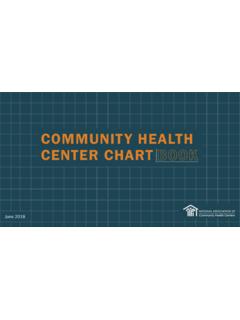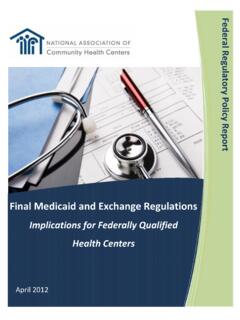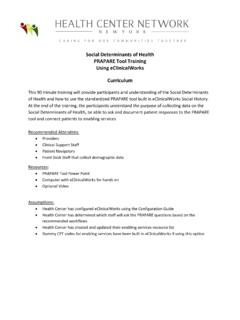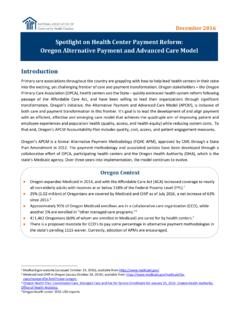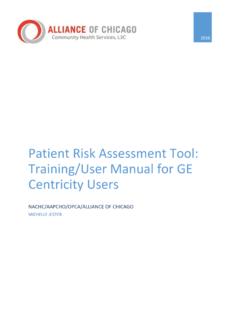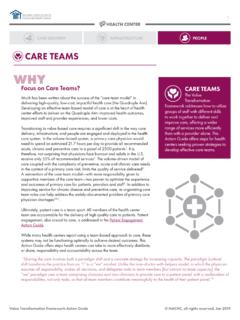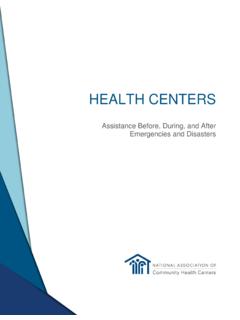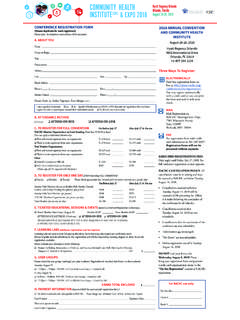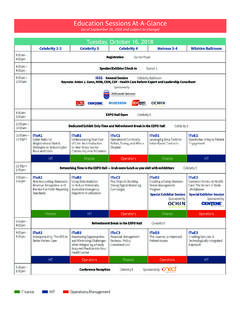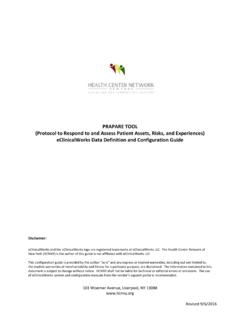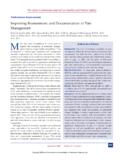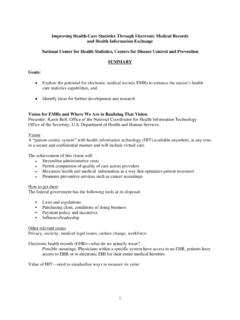Transcription of CARE MANAGEMENT - NACHC
1 2019 National Association of Community health Centers. All rights reserved. | | July 2019 VALUE TRANSFORMATION FRAMEWORK Action Guide care MANAGEMENTV alue-based care requires health care organizations to better control the clinical and financial risk associated with high-risk patients. A systematic process for managing the care of high-risk patients, using proven interventions in a supportive one-on-one environment, has been shown to improve health outcomes1,2,3. High-risk patients, by definition, have multiple health needs often compounded by complex social and other issues. These patients are at risk for poor health outcomes, inadequate quality of care , and increased costs 4,5,6. The Centers for Medicare and Medicaid Services (CMS) recognizes care MANAGEMENT as a critical tool to achieve the Quadruple Aim (better care , better patient and provider experiences, and lower costs)7.
2 This Action Guide provides the steps to start a health center care MANAGEMENT program for high-risk patients. The outlined recommendations meet the requirements of Chronic care MANAGEMENT (CCM) services defined by CMS and, therefore, are eligible for reimbursement. High-risk care MANAGEMENT involves intensive, one-on-one services, provided by a nurse or other health worker, to individuals with complex health and social needs. The formal design of a health center care MANAGEMENT program can ensure a standardized approach to managing high-risk patients by a care manager. The model discussed in this Action Guide is based on a nurse in the role of care manager. Other staffing models can be employed with some modification. Key components of care MANAGEMENT include: identifying and engaging high-risk individuals, providing a comprehensive assessment, creating an individual care plan, engaging in patient education, monitoring clinical conditions, and coordinating needed services8,9, care MANAGEMENT with High-Risk Patients?
3 WHYDoes a High-Risk care MANAGEMENT Model Look Like?WHATCARE MANAGEMENT The Value Transformation Framework addresses how health centers can effectively deliver and coordinate care and manage high-risk and other subgroups of patients with more targeted services. This Action Guide outlines steps health centers can take to develop a comprehensive care MANAGEMENT program for high-risk patients that meets the requirements for reimbursement from the Centers for Medicare and Medicaid Services (CMS).PEOPLEINFRASTRUCTUREHEALTH CENTERCARE DELIVERYV alue Transformation Framework Action Guide 2019 National Association of Community health Centers. All rights reserved. | | July 20192 PEOPLEINFRASTRUCTUREHEALTH CENTERCARE DELIVERYE ligibility for care MANAGEMENT is typically determined through a process of risk stratification (see Risk Stratification Action Guide). For health centers that are new to risk stratification, we recommend a simple yet effective method that sorts patients by number of chronic conditions a technique found in many more advanced risk stratification approaches.
4 This strategy becomes even more reliable when it is combined with a process that allows providers and staff to refer patients that may be missed by simple condition counts8. The goal of risk stratification is to segment patients into distinct groups of similar complexity and care needs. For health centers, these groupings can include: highly complex, high-risk, rising-risk, and low-risk individuals. Unique care models and interventions are then used for each group. This Action Guide focuses on care MANAGEMENT of the high-risk individualized care plan is at the heart of care MANAGEMENT . This plan should be created in partnership with patients and their caregivers. care plans include both short- and long-term goals and address the types and frequency of all planned health , rehabilitation, and mental health treatments, medications, home care and supports, and other services, including who is responsible for each service6.
5 A comprehensive needs assessment aids in the creation of individual care plans for eligible patients. Creating care plans involves more than a standard clinical exam and review of medical and social needs. It includes information on family and informal supports, patient preferences and goals, and functional capabilities in terms of self- care . It also includes feedback from other professionals and specialists ( , dental, social work, or mental health ), as well as information from community partners involved with the patient s care . CMS requirements for Chronic care MANAGEMENT (CCM) can be used to frame a care MANAGEMENT program targeting high-risk patients. Following these guidelines can help ensure that the care MANAGEMENT program, designed to improve patient care and outcomes, can also generate revenue. C ARE MANAGEMENT STEPS: This Action Guide outlines a set of steps that health centers can take to build a care MANAGEMENT program for high-risk patients.
6 STEP 1 Identify or Hire a care Manager: Identify staff to serve as the central point of contact for a panel of high-risk patients. These professionals develop, coordinate, and manage the individual care plans of each patient in their panel. An RN often serves in this role. STEP 2 Identify High-Risk Patients: See the Risk Stratification Action Guide. STEP 3 Define care Manager care Team Interface: Define how, when, and where the care MANAGEMENT program is integrated with the patient s primary care team. care MANAGEMENTto Start-up a High-Risk care MANAGEMENT Model?HOWV alue Transformation Framework Action Guide 2019 National Association of Community health Centers. All rights reserved. | | July 20193 PEOPLEINFRASTRUCTUREHEALTH CENTERCARE DELIVERY STEP 4 Define the Services Provided as Part of care MANAGEMENT : Create a care MANAGEMENT program for high-risk patients that is modeled after CMS s reimbursable CCM services.
7 STEP 5 Enroll Patients in care MANAGEMENT : Establish processes to refer, introduce, and onboard patients into care MANAGEMENT . STEP 6 Create Individualized care Plans: Develop and document personalized care plans by the care manager, in collaboration with the provider and patient. STEP 7 Enhance and Expand Partnerships: Establish relationships with a continuum of providers and other partners in the community for the referral and care of patients health , social, and related needs. STEP 8 Document and Bill for care MANAGEMENT : Utilize the existing EHR care plan template, or create another, to document all billable care MANAGEMENT services. Use applicable diagnosis codes for billing. STEP 9 Graduate Patients from care MANAGEMENT : Establish a process for patients to move out of high-risk care MANAGEMENT as they reach care plan goals and return to routine care and follow-up.
8 STEP 10 Measure Outcomes: Track care MANAGEMENT program effectiveness, including performance on UDS measures, and the extent to which patients reach care plan goals. Identify or Hire a care Manager. The care manager is the central point of contact for a group of high-risk patients typically identified through a risk-stratification process. Most often, the care manager is a registered nurse (RN), but other staffing models may be used. The care manager works with a panel of high-risk patients, one-on-one, to develop and manage their individual care plans. S/he is accountable for coordinating care in partnership with the care team and across the care continuum. This includes consideration of social risk and other issues. The care manager s importance as the central coordinating figure for high-risk patients cannot be overstated. It is important to define the roles and responsibilities of the care manager with a clear job description.
9 health centers can leverage job descriptions previously developed by other care MANAGEMENT programs (sample #1 CM job description). Also, care manager training is critical to Training should include didactic experience as well as mentoring or shadowing8. Skill building in motivational interviewing helps, given that much of the work of care managers requires building trust with patients and caregivers8. Action item: Identify or hire care manager(s), provide a clear job description, and train care manager(s) to manage a full panel of high-risk patients. Identify High-Risk Patients. (See Risk Stratification Action Guide.) Risk stratify the health center s patient population to identify a group of high-risk patients. Depending on the size of the high-risk cohort, and the number of care managers, the program may need to triage the pool of patients into a manageable subgroup for initial focus.
10 For example, it may be easier to start with a specific age group or those in need of a certain preventive service. care MANAGEMENTV alue Transformation Framework Action Guide 2019 National Association of Community health Centers. All rights reserved. | | July 20194 PEOPLEINFRASTRUCTUREHEALTH CENTERCARE DELIVERYThe target caseload for an RN care manager varies depending on several variables. It is likely to be in the range of 50-150 high-risk patients11. Factors affecting caseload size and complexity include: health center environment, the care manager s experience, the clinical and social complexity of patients, available social supports, and target care MANAGEMENT outcomes12. Evaluate caseload size and manageability on an ongoing basis. Action item: Define the caseload of high-risk patients for each care manager based on factors such as his or her experience level and patients social complexity.
